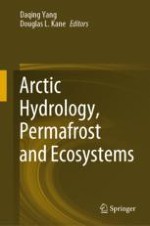2021 | OriginalPaper | Chapter
10. Arctic River Water Temperatures and Thermal Regimes
Authors : Daqing Yang, Hoteak Park, Amber Peterson, Baozhong Liu
Published in: Arctic Hydrology, Permafrost and Ecosystems
Publisher: Springer International Publishing
Activate our intelligent search to find suitable subject content or patents.
Select sections of text to find matching patents with Artificial Intelligence. powered by
Select sections of text to find additional relevant content using AI-assisted search. powered by
